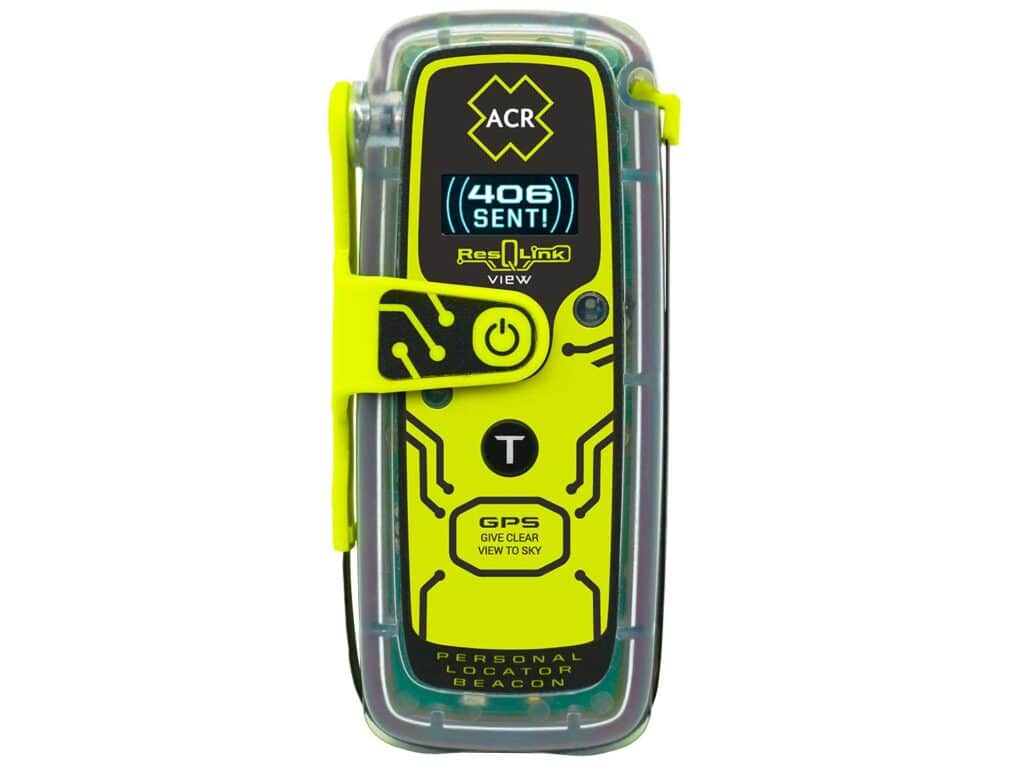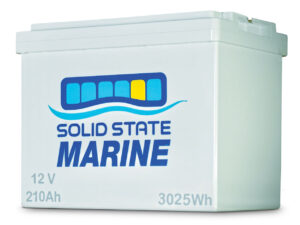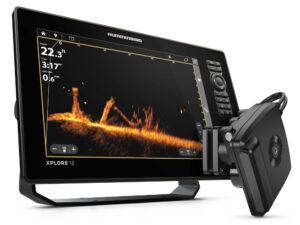
Personal locator beacons (PLBs) and emergency position-indicating radio beacons (EPIRBs) are tools that most boaters hope they will never have to use, but they can literally save your life. Able to instantly transmit a radio distress call via satellite, these high-tech devices work almost anywhere in the world and aren’t limited by cloud cover or extreme weather. Modern PLBs and EPIRBs equipped with built-in GPS are typically able to pinpoint your location down to a 100-meter radius in two to three minutes and instantly transmit it to rescue authorities.
Both PLBs and EPIRBs work by transmitting distress signals to a network of search and rescue satellites called Cospas-Sarsat. The network and beacons communicate on the 406 Mhz radio frequency reserved solely for distress calls worldwide, which is why you’ll sometimes hear them referred to as 406 Mhz beacons. When the satellites pick up a distress signal from a PLB or EPIRB, they relay the information to a global mission control center. Search and rescue authorities then quickly determine the location of the beacon and dispatch rescue teams to the area. Since the first Cospas-Sarsat satellites were launched in 1982, the system has aided in the rescue of more than 46,000 people.
Here’s how to decide which type of beacon is best for you and your type of boating, considerations and recommendations when purchasing, and the answers to some of the most commonly asked questions about emergency locator beacons.
Article at a Glance:
- Both personal locator beacons (PLBs) and emergency position-indicating radio beacons (EPIRBs) link to satellites overhead to quickly and easily send a distress signal, alerting local search-and-rescue (SAR) agencies.
- Personal locator beacons are designed to locate an individual, and should be attached to the user via clip, lanyard or strap.
- Emergency position-indicating radio beacons are registered to a specific person and vessel, and when activated send a distress signal with vital information and GPS position.
- All EPIRBs can be activated manually. Category 1 EPIRBs are also designed to activate automatically in the event a craft is sinking.
- Emergency beacons must be registered with the National Oceanic and Atmospheric Administration (or appropriate authority for non-U.S. boaters) and linked to an individual person or vessel.
- Some satellite communicators also include the ability to send a distress signal.
Types of Marine Emergency/Rescue Beacons
Deciding which type of emergency beacons is best for you depends on a variety of factors, including the size and type of vessel and the remoteness of your boating locations. Here’s a breakdown of the most popular emergency rescue beacons on the market, including PLBs, EPIRBs and satellite communicators with distress-call capability.
- Personal Locator Beacon (PLB): As the name implies, personal locator beacons are meant to locate an individual person. As such, ideally they should be attached to a life jacket or clothing or placed in a pocket. When activated, PLBs send a 406 Mhz satellite signal, which is forwarded to local search-and-rescue organizations along with the holder’s GPS coordinates and basic info such as name, address, emergency contacts and medical conditions. Batteries remain dormant until the device is activated, then typically transmit for 24 to 30 hours. Dormant batteries maintain a charge for up to five years. Some PLBs can transmit brief, pre-programmed nonemergency texts or emails to let friends or family know that the user is OK and provide an update on location. Extras? Consider a model with an LED strobe light to pinpoint your location.
- Emergency Position-Indicating Radio Beacon (EPIRB): Rather than a person, EPIRBs are registered to a vessel. When activated, EPIRBs broadcast a 406 MHz signal that is received and forwarded to the appropriate search-and-rescue organization, such as the Coast Guard or local law enforcement. That signal includes the boat’s name, description and GPS coordinates. Category 2 EPIRBs must be manually activated by someone aboard. Category 1 models can also be manually activated, but include a designated mounting bracket that releases the EPIRB once it senses 6 feet of water pressure. The EPIRB then floats to the surface and begins transmission automatically. Extras? Look for “smart” EPIRBs, which include a display noting the unit’s health and remaining battery life, offer activation prompts, and indicate that emergency messages have been received.
- Satellite Communicators: Designed primarily for satellite-based communication when outside normal cellphone range, satellite communicators wirelessly link to a smartphone to essentially turn your phone into a satellite phone. Most of these devices, including Garmin InReach, Spot X and ACR Bivy Stick, also include interactive SOS messaging in the event of an emergency. All require monthly service plans.
– INVEST TO IMPRESS –
Safety Tip Provided by the U.S. Coast Guard
A boating course is a great way to gain confidence and boat-handling skills. A little practice now will make it look easy when everyone is watching.
Read More: Marine Distress Calls Explained
Recommended PLBs & EPIRBs for Every Boater
PLBs, EPIRBs and satellite communicators are widely available, both online and in marine-/outdoor-specific retail shops. Below is a recommendation for each type of device, based on effectiveness, quality and price.
ACR ResQLink View
Rugged and compact, the buoyant ACR ResQLink offers multiple attachment points, including belt clip and lanyard. When activated, the ResQLink sends an SOS distress signal with GPS coordinates via the 406 MHz Cospas-Sarsat network, along with a 121.5 MHz homing signal to narrow down the search area for responding authorities. Includes an LED strobe light, as well as an infrared strobe light, to pinpoint the wearer’s precise location. $515; Amazon
- Type of beacon: PLB
- Best for: Solo boaters, crewmembers who run the risk of separation from EPIRB-equipped boat
- Price range: $415-$465 – Shop now
- Comparable products: Ocean Signal RescueMe PLB1, McMurdo FastFind 220 PLB
Why we like it: Includes GPS positioning, 406 MHz signal and 121.5 MHz homing capability, along with digital display, strobe and infrared strobe.
Ocean Signal RescueME EPIRB 3
Full-featured 406 MHz global rescue beacon includes AIS technology to allow more precise local information on current beacon position to speed rescue operations. The Return Link Service assures those in distress that their distress signal has been received. Near Field Communication capability allows smartphone monitoring of battery condition and operation. Includes a quick-release bracket, lanyard, and 10-year battery life. $809; West Marine
- Type of beacon: EPIRB
- Best for: Offshore/coastal/Great Lakes cruisers venturing outside cellphone range, boat crews with medical conditions, areas where assistance from other boaters is unlikely.
- Price range: $800 – Shop now
- Comparable products: ACR GlobalFix V4 406 GPS, McMurdo SmartFind G8 AIS, GME MT600G GPS
Why we like it: The RescueMe 3 includes AIS technology and a 121.5 MHz homing signal to speed response time and pinpoint your location for local rescuers, near-field monitoring to view battery status, and both visible and infrared strobe lights.
– UPGRADE YOUR RADIO –
Safety Tip Provided by the U.S. Coast Guard
Digital Select Calling (DSC) allows you to transmit your precise location with the press of a button. Make sure your VHF radio has it, and don’t forget to get your MMSI number. It might just save your life.
Garmin InReach Messenger
This small, lightweight, waterproof satellite communicator offers two-way text messaging outside cellphone coverage. It does not operate on the 406 MHz Cospas-Sarsat network and is not a substitute for a properly registered EPIRB or PLB. However, it does offer global text communications and can send an interactive SOS message in an emergency to Garmin’s monitoring and coordination center, which is staffed 24 hours a day, seven days a week. Rechargeable lithium battery provides up to 28 days of battery life. $299; Bass Pro Shop
- Type of beacon: Satellite Communicator
- Best for: Global two-way messaging, interactive SOS
- Price range: $300 – Shop now
- Comparable products: ACR Bivy Stick, Spot X, Iridium Go
Why we like it: Keeps users connected when beyond cell coverage with two-way messaging and offers interactive SOS messaging.
Considerations When Purchasing an Emergency Beacon
Various factors and included features can influence your choice of an emergency beacon. Here are several worth considering.
- Battery Life — Once activated, emergency beacons transmit continuously. EPIRBs typically have 48 hours of transmitting capacity, PLBs a minimum 24 hours, but individual models can vary. Batteries typically last about five years; most are now user-replaceable while others must be sent to the manufacturer or an authorized dealer for battery replacement. Look for indicators to check remaining battery capacity.
- Category — EPIRBs are available in two categories. Category 1 models can be activated manually, as well as automatically deploy if they are submerged—the latter being beneficial if a boat is sinking. Category 2 models feature only manual activation.
- Return Link Service — This feature offers peace of mind to those sending a distress call that the message has not only been received, but also that the beacon location has been identified.
- AIS Technology —Originally designed to prevent on-water collisions, Automatic Identification System technology sends and receives messages from other AIS-equipped vessels containing a boat’s identity and heading. Its incorporation into some EPIRBs allows an AIS distress alarm to be broadcast to vessels within range, and could potentially speed local rescue operations.
- Flotation — Whether Category 1 or Category 2, EPIRBs are required to float. The same does not apply to PLBs, although for obvious reasons, flotation is a valuable feature for boaters.
- Display — Built-in digital displays are offered on some models. They’re handy for checking battery status, and can give operating instructions, lat/lon positions and other useful information.
How To Rent an Emergency Beacon
Boaters who think they might only occasionally need an emergency beacon and wish to avoid the cost of purchasing one can make use of several rental programs, including those offered by BoatU.S. Foundation. GPS-enabled EPIRBs currently rent for as little as $10 per day, $65 per week or $220 per month; PLBs run $7 daily, $45 weekly and $150 monthly.
– CHECK THE WEATHER –
Safety Tip Provided by the U.S. Coast Guard
The weather changes all the time. Always check the forecast and prepare for the worst case.
Closing Remarks & FAQ:
Have additional questions about visual distress signals and their use? Find a list of frequently asked questions below.
- Do you need to register your PLB?
Yes, both new and used 406 MHz PLBs must be registered with the National Oceanic and Atmospheric Administration, by law. In addition, if you change address, phone number or purchase a new boat, the registration must be updated. Easy online registration is available at beaconregistration.noaa.gov/RGDB/index.
- Do you need to register your EPIRB?
Yes, both new and used 406 MHz EPIRBs must be registered with the National Oceanic and Atmospheric Administration, by law. In addition, if you change address, phone number or purchase a new boat, the registration must be updated. Easy online registration is available at beaconregistration.noaa.gov/RGDB/index.
- What size boat requires an EPIRB?
Commercial fishing vessels operating behind the 3-mile territorial sea line or 3 miles from the coastline of the Great Lakes must carry a 406 MHz EPIRB. A Category 1 EPIRB that will float free and automatically activate is required on vessels 36 feet and above; a manually activated Category 2 EPIRB is allowed on vessels less than 36 feet in length and on craft that have enough documented buoyancy to keep the flooded vessel afloat. In the United States, EPIRBs are not currently required on pleasure craft or recreational boats, but we strongly suggest one for those venturing out into larger waters (uscg.mil).
- Does a PLB satisfy the requirement to carry an EPIRB?
No, a PLB does not satisfy the requirement to carry an EPIRB on commercial vessels.
- What is the difference between Category 1 and 2 EPIRB?
Category 1 EPIRBs are bracket-mounted, and designed to automatically release and activate their emergency signal when submerged to a specific depth, typically 3 to 14 feet. For this reason, they must be mounted outside any cabin in order to be able to float freely away from a sinking vessel.
Category 2 EPIRBs must be manually activated. If installed in a fixed location aboard, they must be manually removed from any bracket for operation.
- Does an EPIRB have to be mounted?
Only Category 1 EPIRBs must be mounted because they utilize a bracket system that releases and activates the EPIRB when submerged to a specific depth. Category 2 EPIRBs may be mounted to ensure they are always readily available in a known location, but they must be removed and manually activated.
- What frequency are EPIRBs?
Modern EPIRBs and PLBs transmit a continuous signal to satellites via the 406 MHz frequency, reserved solely for distress calls worldwide. This signal allows the receiving authority to locate the beacon’s position, and is encoded with the user/vessel’s identity. Some beacons also broadcast a low-power 121.5 MHz homing signal to further locate a beacon’s position.
- What are the rules for PLBs and EPIRBs?
Both PLBs and EPIRBs must be registered with the National Authority of the country you live in. In the U.S., that’s the National Oceanic and Atmospheric Association and you can register free-of-charge at beaconregistration.noaa.gov. A dated registration sticker with a matching Unique Identification Number should also be affixed to the actual device itself. Testing can only be done of a PLB or EPIRB through a specific test position on the activation switch (if equipped) to avoid false alerts. Once activated, a PLB or an EPIRB must be left on until rescued or instructed to turn the unit off from the rescuing agency.
- Where can EPIRBs and PLBs be used?
EPIRBs are intended for maritime use only, but PLBs can also be used off the water by hikers, climbers, aviators and others.








